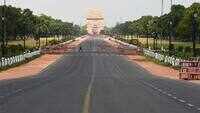
Nagpur: Maharashtra forest minister Sanjay Rathod has said translocating healthy tigers from higher density to lower density areas was the most acceptable solution to mitigate man-animal conflict. Affected people are desperately looking for immediate action from forest department.
Talking to TOI on the burning issue of translocating tigers from Chandrapur on the eve of World Environment Day, Rathod said, “Desperate situations need desperate measures. Chandrapur district alone has 160 tigers which is almost half of the state population of 312.”
“Most alarming thing is that 21 tigers are around 5km periphery of Chandrapur city. Humans and tigers are living together. Tigers become very aggressive when they are with cubs. Many of them have territory on the boundary of villages and city,” he said.
The minister added times humans knowingly or unknowingly crossed these boundaries and are attacked. In the last six years, 113 human deaths have been recorded with 13 of them in last five months, he added.
Maharashtra has 61,936 sqkm forest area, which is 20.13% its total area. Ideally, it should be 33%, but growing population has limited growth of forest area. Forests and wildlife are an integral part of the environment and state forest department was one of the oldest and innovative departments in the country, said Rathod.
The six tiger reserves in the state— Melghat, Tadoba, Sahyadri, Pench, Navegaon-Nagzira and Bor— covering 9,113 sqkm area have come up well in the last 25 years, increasing tiger numbers from 169 in 2010 to 312 in 2018. It is almost doubled in last eight years.
Rathod said all these reserves had collaboratively worked on conservation and protection of tigers. However, conservation of tigers didn’t mean only controlling poaching, but also included avoiding man-animal conflict, welfare activities for tribals, farmers and forests-dwellers, which had yielded positive results, he said.
The forest minister stressed the need for working on increasing prey base for tigers. He said officials were working for developing new prey base areas in different forest circles. “Increase in number of tigers is a matter of pride for us but their territory is limited and hence officials should focus on strengthening corridors,” Rathod said.
“We expect tiger numbers to grow by 270 in Maharashtra in a few years. Of these, number in Chandrapur alone will grow by 60. This will lead to more conflict as locals will continue to venture in forest areas for collection of forest produce,” said Rathod.
The minister said any decision on translocation will be taken after National Tigers Conservation Authority (NTCA) nod. It was already discussed in governing body meeting of NTCA. “We will develop new guidelines and processes for translocation,” he said adding, “The issue of tiger population and conflict needs to be addressed at the earliest.”
Talking to TOI on the burning issue of translocating tigers from Chandrapur on the eve of World Environment Day, Rathod said, “Desperate situations need desperate measures. Chandrapur district alone has 160 tigers which is almost half of the state population of 312.”
“Most alarming thing is that 21 tigers are around 5km periphery of Chandrapur city. Humans and tigers are living together. Tigers become very aggressive when they are with cubs. Many of them have territory on the boundary of villages and city,” he said.
The minister added times humans knowingly or unknowingly crossed these boundaries and are attacked. In the last six years, 113 human deaths have been recorded with 13 of them in last five months, he added.
Maharashtra has 61,936 sqkm forest area, which is 20.13% its total area. Ideally, it should be 33%, but growing population has limited growth of forest area. Forests and wildlife are an integral part of the environment and state forest department was one of the oldest and innovative departments in the country, said Rathod.
The six tiger reserves in the state— Melghat, Tadoba, Sahyadri, Pench, Navegaon-Nagzira and Bor— covering 9,113 sqkm area have come up well in the last 25 years, increasing tiger numbers from 169 in 2010 to 312 in 2018. It is almost doubled in last eight years.
Rathod said all these reserves had collaboratively worked on conservation and protection of tigers. However, conservation of tigers didn’t mean only controlling poaching, but also included avoiding man-animal conflict, welfare activities for tribals, farmers and forests-dwellers, which had yielded positive results, he said.
The forest minister stressed the need for working on increasing prey base for tigers. He said officials were working for developing new prey base areas in different forest circles. “Increase in number of tigers is a matter of pride for us but their territory is limited and hence officials should focus on strengthening corridors,” Rathod said.
“We expect tiger numbers to grow by 270 in Maharashtra in a few years. Of these, number in Chandrapur alone will grow by 60. This will lead to more conflict as locals will continue to venture in forest areas for collection of forest produce,” said Rathod.
The minister said any decision on translocation will be taken after National Tigers Conservation Authority (NTCA) nod. It was already discussed in governing body meeting of NTCA. “We will develop new guidelines and processes for translocation,” he said adding, “The issue of tiger population and conflict needs to be addressed at the earliest.”

Coronavirus outbreak
Trending Topics
LATEST VIDEOS
City
 Kerala pregnant elephant killing: Preliminary post-mortem reports out
Kerala pregnant elephant killing: Preliminary post-mortem reports out  Bigger tremors round the corner in Delhi-NCR?
Bigger tremors round the corner in Delhi-NCR?  2,550 foreign Tablighi Jamaat members blacklisted by Home Ministry; entry into India banned for 10 years
2,550 foreign Tablighi Jamaat members blacklisted by Home Ministry; entry into India banned for 10 years  Justice will prevail: Kerala CM Pinarayi Vijayan on killing of pregnant elephant
Justice will prevail: Kerala CM Pinarayi Vijayan on killing of pregnant elephant
More from TOI
Navbharat Times
Featured Today in Travel
Quick Links
Kerala Coronavirus Helpline NumberHaryana Coronavirus Helpline NumberUP Coronavirus Helpline NumberBareilly NewsBhopal NewsCoronavirus in DelhiCoronavirus in HyderabadCoronavirus in IndiaCoronavirus symptomsCoronavirusRajasthan Coronavirus Helpline NumberAditya ThackerayShiv SenaFire in MumbaiAP Coronavirus Helpline NumberArvind KejriwalJammu Kashmir Coronavirus Helpline NumberSrinagar encounter
Get the app



